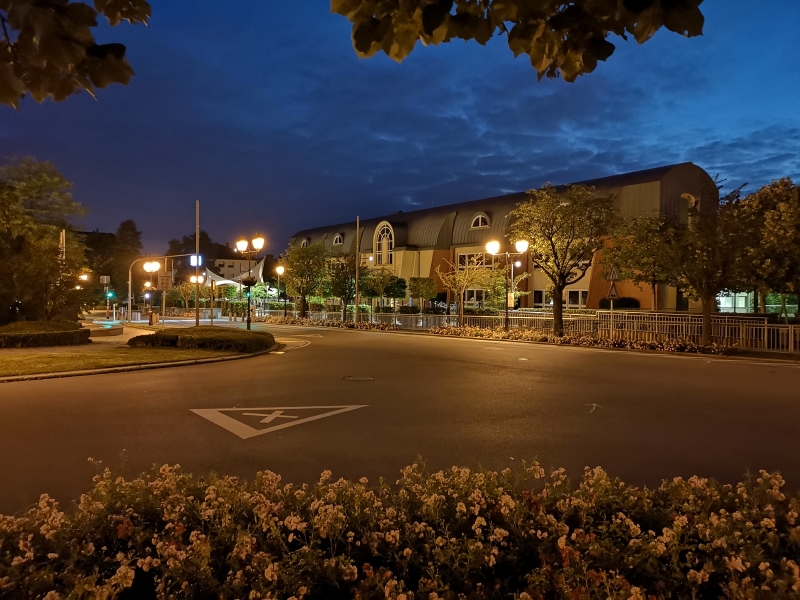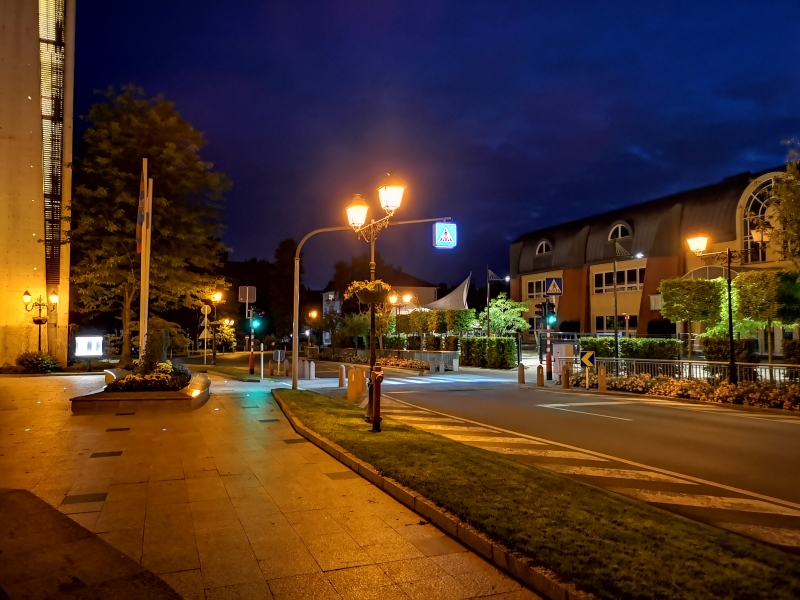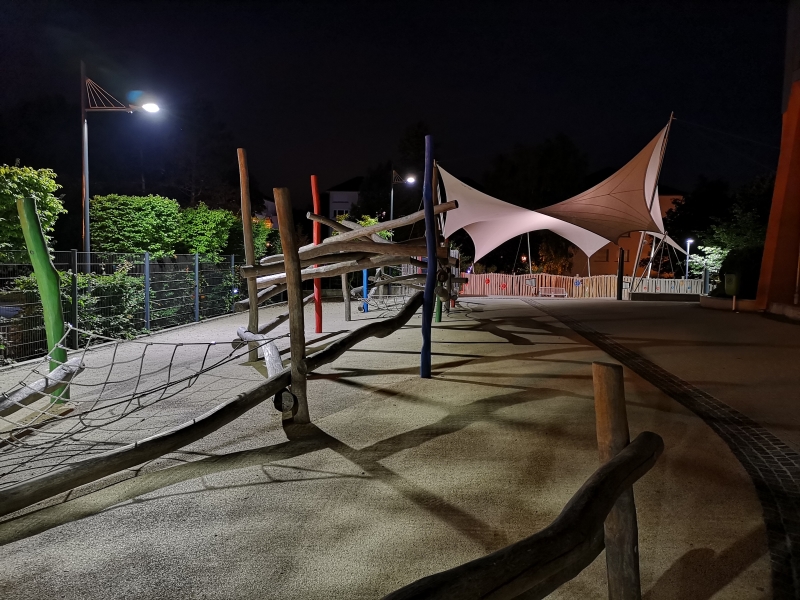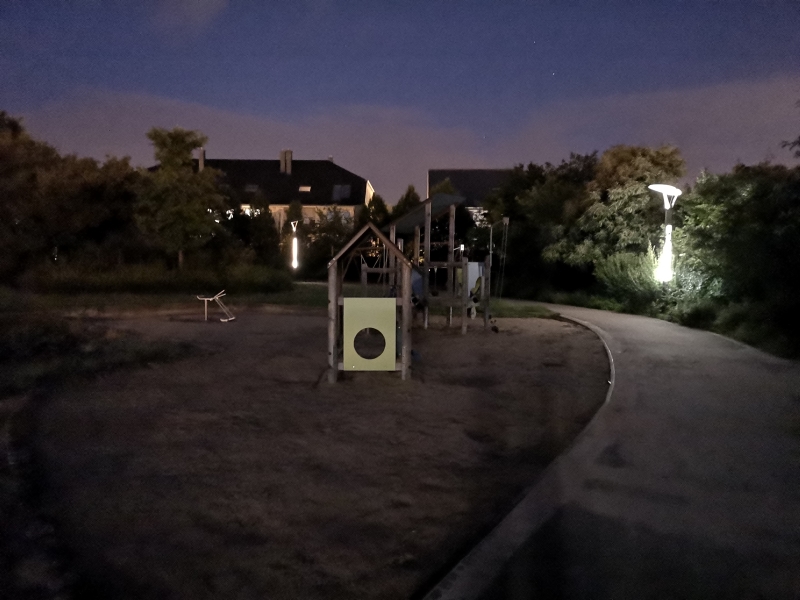The Huawei P20 & P20 Pro Review: Great Battery Life & Even Better Night Vision
by Andrei Frumusanu on June 15, 2018 11:00 AM ESTCamera - Low Light Evaluation
Low-light photography is one area the where the P20 Pro and P20 promised to bring great improvements. On the P20 Pro this is largely achieved through the ability of the sensor to do pixel binning and thus combine 2x2, meaning four, physical pixels into a single logical pixel. In theory this improves light sensitivity of the sensor by 4x and equivalent to a sensor with 2µm pixel pitches, which would make it by far the most sensitive sensor in smartphones.
Another feature to complement the improved low light capture and processing abilities of the P20s is a much improved “Night” mode. This was a feature which was present in Huawei cameras for some time now, essentially it is a multi-frame long-exposure capture mode that does computational combination of the shots into a single resulting high exposure shot. The difference with the P20 versus past implementations is the fact that the algorithm has now substantially improved shake compensation, meaning it’s now actually usable in handheld mode without a tripod and it will still come out sharp.
[ P20 Pro ] - [ P20 ] - [ P10 ]
[ Galaxy S9+ ] - [ iPhone X ] - [ Mi MIX 2S ] - [ Pixel 2 XL ]
Starting off with the first scene after sundown, we see that the P20 Pro’s 40MP shooting mode becomes very uncompetitive in low light due to its 1µm pixel pitch, and although both shots opt for the same exposure time and ISO, the 40MP clearly suffers from blurriness and lack of detail.
The P20 Pro’s 10MP shot is able to offer much better dynamic range and thus also better contrast than the Galaxy S9 or for that matter any of the other comparison devices. The P20 also does extremely well in terms of exposure, coming very similar to the P20 Pro, but having a noticeable disadvantage in terms of detail retention.
[ P20 Pro ] - [ P20 ] - [ P10 ] - [ Mate 10 Pro ]
[ Galaxy S9+ ] - [ iPhone X ] - [ Mi MIX 2S ] - [ Pixel 2 XL ]
In this shot the P20’s were the only phones to have sufficient dynamic range to now blow out too much of the blue street crossing sign as well as the left message board. The P20 again posts very similar exposure as the P20 Pro – but lagging behind in terms of overall detail. While the P20’s won in dynamic range, they lose out in terms of detail retention against the competition. Unfortunately all of my S9 shots ended up out of focus for some reason so that shot should only be used as a comparison in terms of exposure.
[ P20 Pro ] - [ P20 ] - [ P10 ] - [ Mate 10 Pro ]
[ Galaxy S9+ ] - [ iPhone X ] - [ Mi MIX 2S ] - [ Pixel 2 XL ]
In this scene, the P20 Pro outright flexes its muscles as it’s able to be the uncontested winner in terms of dynamic range, exposure, colour balance and detail retention by a large margin over all other phones. The P20 follows the P20 Pro in terms of exposure, but its detail retention is no better than competing smartphones.
Extreme low light photography
Generally for the P20 Pro, the less light there is, the better it will perform when compared to the competition. So stark is the difference in light capture capability, that generally there’s very little the other phones can do. I decided to have a little fun and throw the phones into what is essentially impossible scenarios where you wouldn’t expect a normal camera, yet alone a smartphone to perform.
[ P20 Pro ] - [ P20 ]
[ P10 ] - [ Mate 10 Pro ]
[ Galaxy S9+ ] - [ iPhone X ] - [ Mi MIX 2S ] - [ Pixel 2 XL ]
In this first scene there’s little to talk about existing phones as they mostly aren’t able to capture much at all besides some bushes around the light post. The P20 and P20 Pro on the other hand are able to resolve enough that we can actually make out what’s in the scene. The night mode on both phones demonstrate just what is possible in terms computational photography and the results are impressive.
On the P20 Pro in particular is particularly able to resolve a stupid amount of detail while this effectively was a 6 second handheld exposure.
But the real impressive shot is actually the regular 10MP mode – the camera here kicked in into high ISO mode and the resulting shot is a 1/4th second exposure at ISO51200, essentially a first in a smartphone.
[ P20 Pro ] - [ P20 ]
[ P10 ] - [ Mate 10 Pro ]
[ Galaxy S9+ ] - [ iPhone X ]
The second extreme low light scene has just a little more light as it’s being faintly illuminated by the dim walkway light. Again the P20 Pro’s 10MP mode shot results in a 1/4th second exposure at ISO51200 and the result is just astounding, and pardon the pun, simply night and day when compared to other phones. Even though the P20 doesn’t have any special light capture hardware, in Night mode it still manages to vastly outperform the competition. Funnily enough, the Mate 10 performs really well in terms of exposure in its Night mode here, but as it lacks the shake compensation feature of the P20’s, the resulting image is quite a blurry mess, and why that mode was generally unusable in the past unless you put the phone on a tripod or fixture.
Generally the P20 and P20 Pro impressed in low-light capture. The P20 doesn’t have any special hardware so most of its quality improvement are solely due to software processing improvements. Night mode in particular as a concept isn’t anything that’s bound to any hardware configuration so it’s fantastic to see Huawei push innovation and evolving it into something really special.
In terms of actual light capture, the P20 Pro’s massive sensor is just without competition. Both the hardware and the software processing make this easily the most competitive smartphone in low-light scenarios. At high ISO settings, we’re seeing astounding and never-before-seen results from a smartphone that really pushes the envelope of what can be done in a mobile device.













































81 Comments
View All Comments
chrnochime - Friday, June 15, 2018 - link
Widespread success in western market? Europe maybe but North America? I doubt it.Retycint - Friday, June 15, 2018 - link
Literally in the next paragraph, "put an end to Huawei’s ambitions in the US ... However, outside the US, Huawei products are as popular as ever"It would be good to remember that US is just one country out of 'Western countries", and in Europe Huawei is one of the top selling brands on par with Apple/Samsung.
Lord of the Bored - Saturday, June 16, 2018 - link
US is the only western country that matters, though.beginner99 - Saturday, June 16, 2018 - link
Except that Europe has double the population from US...mkaibear - Saturday, June 16, 2018 - link
>double the population from US...And a bigger economy. Admittedly the US GDP/capita is higher but...
dustwalker13 - Sunday, June 17, 2018 - link
only if you take the whole EU as a unit including the comparatively poor eastern european countries.central europe has the us beat in terms of gdp/capita and the total economic power of the pop of the whole eu is significantly higher than the us.
in the end though, neither the us nor eu are as big as the asian market at this point. i find the 'merica! guys almost funny. it is like watching an old society lady bitch about that progressive lord next door, imagining her opinion had any weight still, while in reality both are sitting in crumbling castles and the world has moved on years ago.
FunBunny2 - Monday, June 18, 2018 - link
"only if you take the whole EU as a unit including the comparatively poor eastern european countries."well, as Crooked Hillary said (and it's true) her votes came from districts that produced 65% of GDP. The Evil One, of course, snuck in on the basis of the skewed Electoral College biased to the low information, low income, low education empty states. the poor will always be with you.
peevee - Tuesday, June 19, 2018 - link
This is simply not true.Districts do not produce GDP, working people do.
And most poor and stupid actually voted for Clinton:
<$50,000 53% Clinton 41% Trump
$50,000-$100,000 46% Clinton 49% Trump.
$100,000 & over 47% 47%
https://ropercenter.cornell.edu/polls/us-elections...
Keep telling yourself the lies though.
Round - Tuesday, June 26, 2018 - link
This is supposed to be about a second rate phone from china and gullible buyers, not politics, but oh well...The only problem with Crooked Hillary (besides her not being in a CIA black-site prison for the rest of her unnatural life) and her comment/assessment, is that many highly-educated, high intelligent people decided that her brand of sociopathy was too much for them. Many hard working, also intelligent, people also found her lies too hard to swallow.
While we have a crass and utter buffoon in office now, the myth that anyone smart enough to see Hillary for the conniving waste she is must be "low information, low income, low education" is only believed - and spewed ad nauseam - by the malignantly ignorant, non-thinking masses of clueless progressives. N.B. I an NOT talking about democrats (an endangered species), I'm only talking about the worst ignorant identity-politicing progressives.
Perhaps learning what Hillary's globalism really means to Americans and the GDP/per capita income, instead of relying upon the dishonest pablum coming from the nuts and sociopaths on the left would be worth some time. Just a thought.....
peevee - Tuesday, June 19, 2018 - link
"central europe has the us beat in terms of gdp/capita"False. Only tiny countries like Switzerland and Luxembourg (in the latter case because of out-of-country commuters - similar mistake like GDP per capita in the suburbia-dominated American cities incorrectly calculated by taking product produced by all people working in the cities, including commuters from suburbs (usually producing the most product by value), but dividing them only by the number of people living in the cities.
Statistical slight of hand, one of the many employed by liars.